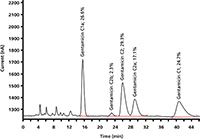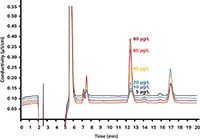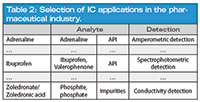Ion Chromatography – A Versatile Tool in Pharma Analysis
The Application Notebook
Metrohm
High standards have to be met by the pharmaceutical industry when it comes to drug quality and safety. These standards are documented in pharmacopoeias as officially recognized pharmaceutical rules, and published as legal tools of customer protection by authorities such as governments and medical societies. The identification of a drug depends on sensitive, reliable instruments and methods — as does the determination of the drug's compliance with applicable regulations.
Ion chromatography (IC) is the method of choice to determine active ingredients, excipients, and traces of impurities, as well as metabolites in the form of organic and inorganic ions or polar substances, in a number of pharmaceuticals, pharmaceutical solutions, and even body fluids. It can determine several substances within a very short time in a single analysis — and can even distinguish chemically similar analytes. The concentration of analytes can vary from ng/L up to the per cent range. The large selection of separation columns and elution systems available makes IC useful for almost any kind of analyte. Interfering effects caused by the sample matrix can easily be avoided by using the right sample preparation or choosing a suitable detection method. In-line sample preparation is a feature of many modern IC systems, as the focus of recent advances in IC has been mainly on ease of use. However, convenience is not the only advantage brought by automation of the IC process: Reducing human interference to a minimum also means reducing the chances of mistakes and contamination.
Depending on the requirements of analyte and matrix, there is a broad range of detection methods to choose from:
- Conductivity detection with and without suppression
- Amperometric detection
- Spectrophotometric detection with and without post-column derivatization (UV–vis)
- Coupled detection methods such as IC–MS and IC–ICP–MS
Pharmaceutical samples come in many different forms which require different ion chromatographic approaches. What follows is an overview of frequent sample types with example analyses.
Pharmaceutical Solutions
The term "pharmaceutical solutions" denotes isotonic solutions, hemodialysis solutions, or infusion solutions. They contain anions, cations, carbohydrates, and organic acids, the concentrations of which frequently differ from one another by several orders of magnitude. Within the context of production monitoring and final quality control, an analysis method is required that can determine these ingredients with a high degree of precision. In addition, the analysis should be quick and require minimal effort. With its intelligent analytical procedure and automatic in-line sample preparation, IC fully accomplishes this task.
Two example analyses of hemodialysis solutions are shown in Figures 1–2. Patients suffering from renal failure require hemodialysis to compensate for the loss of the kidney's blood-cleansing function. During the process, the patient's blood exchanges solutes with a hemodialysis solution through a semipermeable membrane. The exchanged solutes include, among others, waste products such as urea and phosphate, which diffuse out of the blood and into the dialysis solution along the concentration gradient. The composition of dialysis solutions is complex because the removal of solutes from the blood changes its osmotic activity; therefore, it has to take place at a controlled rate, which is achieved by the right solute concentration. A strong change in osmotic activity can cause dialysis disequilibrium syndrome where, because of the low solute concentration in blood, solutes are washed out from other body compartments.

Figure 1: IC measurement on a Metrosep A Supp 7 - 250/4.0 using Na2CO3 gradient elution, followed by sequential suppression and conductivity detection. (a): Anion standard including acetate and citrate; (b): acetate and citrate in hemodialysis solution.
Figure 1 shows the simultaneous determination of citrate and acetate in diluted hemodialysis solution. In part A, an anion standard was measured; part B shows the sample determination. Citrate is added to hemodialysis solutions for its anticoagulant properties and acetate is added as a buffer substance. It is transferred to the patient's bloodstream during hemodialysis and stabilizes the blood's pH value. This is necessary because the kidneys of dialysis patients are not capable of excreting acid components – therefore, patients are often acidotic.
Besides citrate and acetate, the chromatogram reveals the presence of a close to physiological concentration of chloride. By using physiological solute concentrations, the concentration gradient is reduced to a minimum and a dynamic equilibrium is reached between the blood and dialysis solution. The loss of certain solutes — including chloride — is thereby prevented.
Figure 2 shows the determination of cations in hemodialysis concentrate after an automated in-line dilution step. Like chloride, the cations are present in close to physiological concentrations to avoid their drainage from patients' blood by osmosis.

Figure 2: Cations in diluted hemodialysis concentrate using the Metrosep C 4 - 150/4.0 column and non-suppressed conductivity detection.
Active Pharmaceutical Ingredients
Active pharmaceutical ingredients (APIs) in medicines such as gentamicin, neomycin, cefadroxil, or bethanechol chloride can be determined by IC in accordance with the regulations of the U.S. Pharmacopeia and European Pharmacopoeia. The requirements regarding precision, separation, and recovery of the analytes are described in detail in the pharmacopoeias. Figure 3 depicts the ion chromatogram of an analysis of gentamicin, an antibiotic belonging to the group of aminoglycosides. Aminoglycosides are bactericidal antibiotics that block protein biosynthesis by binding to ribosomes, thereby causing mistakes in the translation from mRNA to DNA. Gentamicin consists of several closely related compounds, namely gentamicin C1, gentamicin C1a, and gentamicin C2, C2a, and C2b. In spite of their structural similarity, IC achieves a good separation of the different gentamicin components.

Figure 3: IC determination of the antibiotic gentamicin by pulsed amperometric detection; column: Polymer Laboratories RP-S; eluent: 60 g/L Na2SO4, 1.75 g/L sodium octane sulphonate, 1.34 g/L NaH2PO4, 8 mL/L THF (pH = 3, H3PO4); post-column addition: 300 mmol/L NaOH.
Impurities in Pharmaceuticals
Apart from API analysis, it is also possible to determine impurities in pharmaceutical products by IC. Even small concentrations of an impurity can cause significant side effects. For example, in the synthesis of the antihypertensive irbesartan, azide can be detected in traces as an impurity in the product. Azide is strongly toxic to humans and its concentration in irbesartan is therefore subject to rigorous controls. The U.S. Pharmacopeia recommends ion chromatographic azide determination after direct injection according to USP<621>. In this method, a transfer solution consisting of the IC eluent and a suitable organic solvent is used to remove the API from the analytical column. However, this procedure is tedious, time-consuming, and cannot be automated.

Figure 4: Irbesartan sample spiked with 5â80 µg/L azide; column: Metrosep A Supp 10 - 250/4.0; eluent: 5 mmol/L Na2CO3, 5 mmol/L NaHCO3; inline matrix elimination with 70:30 (v/v) methanol/water.
Azide determination is more selective, more sensitive, and, above all, quicker with the use of in-line matrix elimination, where the interfering pharmaceutical matrix is separated from the target analyte in the course of sample preparation. The ion chromatogram in Figure 4 shows the analysis of an irbesartan sample spiked with different concentrations of azide. The signal is recorded by a conductivity detector following sequential suppression. Table 1 lists the average recovery values of azide that were achieved over three measurements, as well as the mean conductivity measured by the detector and the relative standard deviation.

Table 1: Precision and recovery of azide.
The determination of azide in irbesartan with preceding matrix elimination fulfills all requirements of the regulatory authorities, which concern the selectivity of the method, its limits of detection and quantitation, precision, linearity, accuracy, and robustness. Therefore, it can be used as a quicker and more sensitive alternative to the proposed determination according to USP<621>.

Table 2: Selection of IC applications in the pharmaceutical industry.
Conclusion
Today, IC covers a diverse field of applications in the pharmaceutical industry. A selection of three out of more than 80 applications is listed in Table 2. The technique has become extremely versatile because of the large number of different columns, eluent and gradient options, sample preparation techniques, and automation possibilities that are available to the user.
Metrohm International Headquarters
Ionenstrasse, 9101 Herisau, Switzerland
Tel: +41 71 353 85 04
Website: www.metrohm.com
















